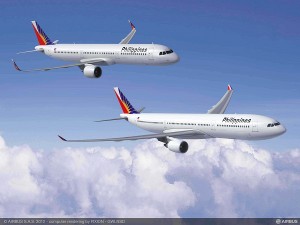
REFLEETING DEAL SIGNING. PAL and Airbus officials pose after the signing ceremony at Century Park Hotel, from left, PAL vice chairman and treasurer Harry C. Tan, PAL Chairman Dr. Lucio C. Tan, Airbus Senior VP for Asia Jean Francois Laval and PAL President Ramon S. Ang.
MANILA, Philippines–Philippine Airlines has sealed a deal for as many as 85 wide- and narrow-bodied jetliners from the world’s biggest aircraft manufacturer Airbus Industrie in a transaction that the flag carrier is set to announce Tuesday.
According to industry sources familiar with the matter, the first phase of the multiyear acquisition spree would see PAL acquiring up to 54 aircraft (raised from an initial order of 35) from the European plane maker to boost its current fleet of 39 jets.
A report by Reuters released Tuesday pegs the total value of the deal’s first batch at $7 billion at the plane manufacturer’s list prices, although discounts for large orders are customary in the industry.
The new batch of aircraft is reported to include up to 10 A330-300 twin-aisle jets, which will be deployed to PAL’s regional and mid-range flights, including its expected return to the Middle East market.

PAL BUYS AIRBUS JETS. Philippine Airlines has inked with Airbus the biggest aircraft deal in Philippine history involving a firm order for more than 50 single-aisle and wide-body jets which are shown in this photo, with a list price of approximately US$7 billion. CONTRIBUTED PHOTO
The rest of the order will come in the form of single-aisle A320 jets and their higher-capacity variant, the A321, which will be used for regional and short-haul domestic flights.
The source added that orders for A320 and A321 aircraft would be in the form of Airbus’ “neo” or New Engine Option planes, which could provide operators with as much as 20-percent cost savings in terms of fuel consumption.
PAL selected the Airbus A320neo and A321neo, in particular, because of its efforts to reduce operating costs, especially since fuel accounts for as much as 45 percent of the flag carrier’s expenses.
The PAL-Airbus deal was supposed to be announced as early as last month during the biennial Farnborough Airshow in the United Kingdom, but was delayed due to last minute negotiations, according to people familiar with the deal.
Earlier, PAL president and San Miguel group head Ramon S. Ang said the airline would acquire as many as 100 aircraft over the next few years as part of its refleeting efforts.
The balance of the 100-plane acquisition plan is expected to go to Airbus’ rival, Boeing, in anticipation of the country being restored to Category 1 status by the US Federal Aviation
Administration.
Under the Philippines’ current Category 2 status, PAL is prohibited from using planes other than its current and aging Boeing 747-400s and Airbus A340-300s for flights to the US West Coast. The flag carrier is also prohibited from mounting additional flights to US destinations despite the growing demand from direct trans-Pacific flights between the two countries.
PAL operates eight aircraft manufactured by Boeing, namely three B777-300ERs and five 747-400s. It has 31 Airbus jets in its fleet, made up of four A340-300s, eight A330300s, 15 A320-200s, and four A319s.
PAL recently placed an order for three more B777-300ERs, which can match the range of the B747, but has more efficient fuel consumption since the former model only has two engines compared to the latter’s four.
Last week, PAL’s parent firm, PAL Holdings, reported that it had posted a comprehensive net income of P489.2 million, marking a significant turnaround from the P475.1-million loss in the same three-month period last year. Total revenues for the first quarter of the current fiscal year amounted to P20.8 billion or 5.8 percent higher than last year’s P19.6 billion.

